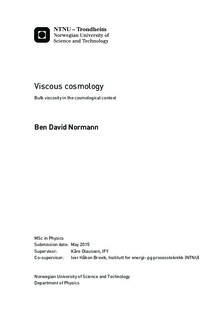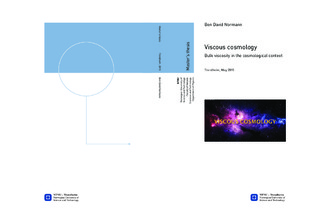| dc.description.abstract | The main objective of this thesis has been to estimate the present value of the bulk viscosity of the cosmic fluid. The following list contains a summary of the main results found in the present work:
-The bulk viscosity is estimated for a two-component fluid consisting of pressure-less matter in mixture with the cosmological constant and also for a one-component fluid. Comparison with observations of the Hubble parameter as a function of redshift is performed. The investigation reveals that the magnitude of the viscosity is highly dependent on the model used.
-The formalism and results found in a recent paper by J. Wang and X. Meng is discussed and put on vitally more solid ground through more accurate solutions of the energy equation together with the Friedmann equations. This is seen as one of the major contributions given through the present work.
-For the one-fluid a degeneracy between the functional forms found in the literature for the equation of state parameter and the bulk viscosity is pointed out. It is found instructive to use a constant equation of state parameter instead, and to include all inhomogeneity in the viscosityinstead. In this case the viscosity is bound to be negative.
-For a constant equation of state parameter in the one-fluid case, it is shown that - with the functional form considered for the viscosity - no other choice than -1 can explain observations well.
-In general for the one-fluid case, a viscosity proportional to the energy density is shown to give a rather good fit of the Hubble parameter measurements, whereas a functional form proportional to the square root of the energy density by eye sight gives a clearly less correct fit.
-When allowing for a varying equation of state parameter, however, both positive, negative and zero viscosity explains observations equally well. This is shown to be a consequence of having both a varying equation of state parameter and a varying viscosity.
-An estimate obtained from small perturbations of the overall cosmic pressure is shown to suggest an order of magnitude 10^6 Pa s for the present day viscosity. This is in good agreement with the amount of viscosity that is needed to make a visible change in the plotted curves of the Hubble parameter as a function of redshift. This is shown to be true for the two component fluid as well as for the one-fluid.
-Finally, through applying kinetic theory, as well as using Winberg's formalism, a non-negligible candidate is found as a cause for the viscosity; electromagnetic radiation slightly out of thermal equilibrium with matter. The present value of this viscosity is estimated to be 10^3 Pa s. | |

